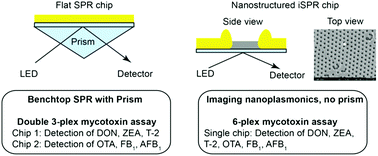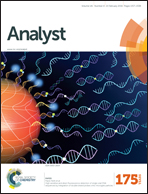Multiplex surface plasmon resonance biosensing and its transferability towards imaging nanoplasmonics for detection of mycotoxins in barley†
Abstract
A 6-plex competitive inhibition immunoassay for mycotoxins in barley was developed on a prototype portable nanostructured imaging surface plasmon resonance (iSPR) instrument, also referred to as imaging nanoplasmonics. As a benchmark for the prototype nanoplasmonics instrument, first a double 3-plex assay was developed for the detection of deoxynivalenol (DON), zearalenone (ZEA), T-2 toxin (T-2), ochratoxin A (OTA), fumonisin B1 (FB1) and aflatoxin B1 (AFB1) using a well-established benchtop SPR instrument and two biosensor chips. To this end, ovalbumin (OVA) conjugates of mycotoxins were immobilized on the chip via amine coupling. The SPR response was then recorded upon injection of a mixture of antibodies at a fixed concentration and the sample (or matrix-matched standard) over a chip with immobilized mycotoxin–OVA conjugates. The chips were regenerated after each sample using 10 mM HCl and 20 mM NaOH and could be used for at least 60 cycles. The limits of detection in barley (in μg kg−1) were determined to be 26 for DON, 6 for ZEA, 0.6 for T-2, 3 for OTA, 2 for FB1 and 0.6 for AFB1. Preliminary in-house validation showed that DON, T-2, ZEA and FB1 can be detected at the European Union regulatory limits, while for OTA and AFB1 sensitivities should be improved. Furthermore, measurement of naturally contaminated barley showed that the assay can be used as a semi-quantitative screening method for mycotoxins prior to liquid chromatography tandem mass spectrometry (LC-MS/MS). Finally, using the same bio-reagents the assay was transferred to a 6-plex format in the nanoplasmonics instrument and subsequently the two assays were compared. Although less sensitive, the 6-plex portable iSPR assay still allowed detection of DON, T-2, ZEA and FB1 at relevant levels. Therefore, the prototype iSPR shows potential for future applications in rapid in-field and at-line screening of multiple mycotoxins.

- This article is part of the themed collection: Detecting food authenticity and integrity

 Please wait while we load your content...
Please wait while we load your content...